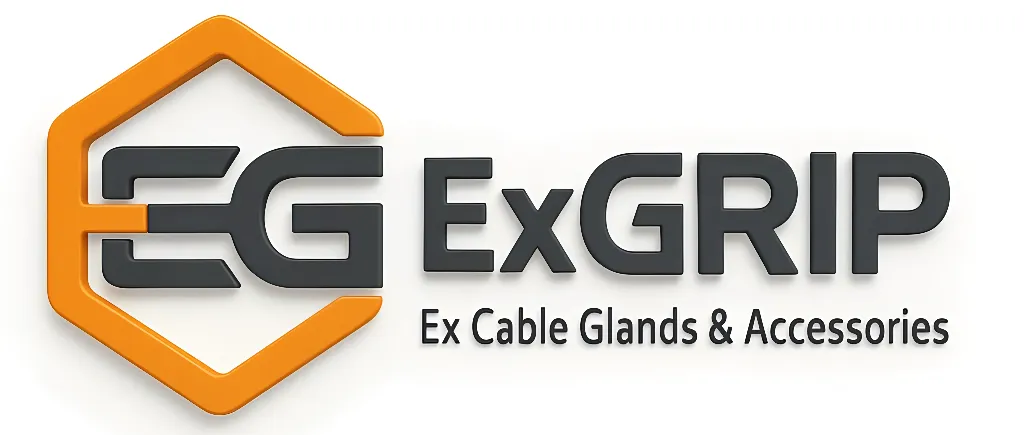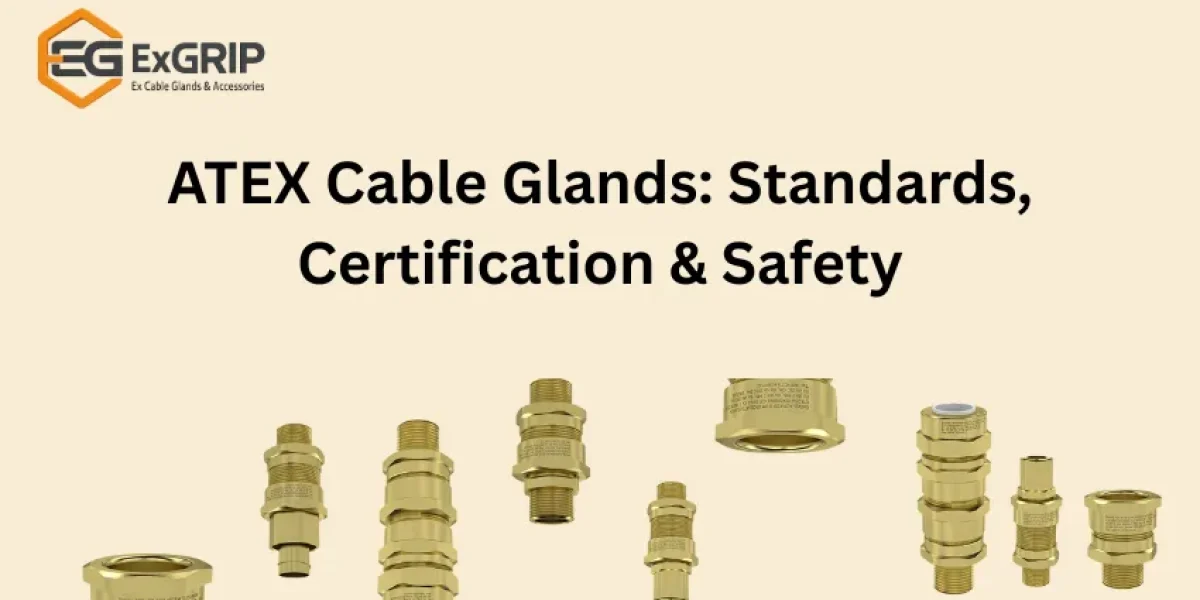In hazardous industrial environments, electrical safety is paramount, and cable connections play a critical role in maintaining it. ATEX cable glands are specialized components designed to secure cables while ensuring compliance with safety standards in explosive atmospheres. These mechanical fittings are essential in industries like oil & gas, chemical processing, pharmaceuticals, and mining, where improper cable termination could lead to catastrophic incidents.
At Exgrip, we provide a comprehensive range of ATEX certified cable glands, engineered to meet stringent safety regulations while offering durability, reliability, and ease of installation.
What Are ATEX Cable Glands?
An ATEX cable gland is a mechanical device that terminates and secures the end of a cable to electrical equipment installed in hazardous areas. Unlike standard cable glands, ATEX-certified versions are designed for explosive atmospheres, preventing sparks or flame propagation that could ignite flammable gases, vapors, or dust.
Key Functions:
Explosion Protection: Designed to contain sparks or flames inside the equipment, preventing ignition outside.
Sealing and Strain Relief: Provides ingress protection against dust, water, and other environmental factors.
Mechanical Security: Ensures cables remain fixed even under vibration, mechanical stress, or accidental pulling.
Electrical Continuity: For armoured cables, ATEX cable glands maintain grounding and bonding with the enclosure.
These glands are typically made from brass, stainless steel, or high-grade polyamide, offering both durability and corrosion resistance in harsh industrial conditions.
Why ATEX Certification Matters
Using a non-certified cable gland in a hazardous area can have serious consequences, including equipment failure, fires, and even loss of life. ATEX certification guarantees that the product has undergone rigorous testing and complies with the European Union ATEX Directive 2014/34/EU, which regulates equipment intended for explosive atmospheres.
Benefits of ATEX Certified Cable Glands:
Compliance with Global Safety Standards: Ensures adherence to ATEX, IECEx, and other relevant directives.
Reduced Risk of Explosion: Proper sealing, mechanical strength, and flameproof features minimize hazards.
Longevity: Materials and construction designed to withstand industrial wear and environmental stress.
Peace of Mind: Engineers and plant managers can trust the reliability of the installation.
At Exgrip, all our ATEX cable glands are tested for quality, durability, and compliance, giving clients confidence in high-risk installations.
ATEX Cable Gland Standards
Understanding ATEX standards is crucial for selecting the right cable gland. The standards categorize equipment and protective systems based on their suitability for explosive atmospheres.
Zone Classification
ATEX divides hazardous areas into zones according to the type and frequency of explosive substances:
Zone 0: Area where explosive gas is present continuously or for long periods.
Zone 1: Area where explosive gas is likely to occur during normal operation.
Zone 2: Area where explosive gas is not likely but could occur.
Zone 20, 21, 22: Equivalent zones for explosive dust.
ATEX cable glands are selected according to the zone classification, ensuring the right level of flameproof protection.
Equipment Protection Levels (EPL)
The ATEX directive also defines the equipment protection level (EPL) for hazardous areas:
Ga / Da: Very high protection for Zone 0/20 (continuous presence).
Gb / Db: High protection for Zone 1/21 (likely presence).
Gc / Dc: Normal protection for Zone 2/22 (unlikely presence).
Choosing a cable gland with the appropriate EPL ensures that the installation remains safe under expected environmental and operational conditions.
Construction and Material Standards
ATEX cable glands must comply with specific mechanical and material standards:
Brass or Stainless Steel: For corrosion resistance and mechanical durability.
Polyamide (Nylon): For lightweight indoor applications.
IP Ratings (Ingress Protection): Typically IP66, IP67, or IP68 for water and dust resistance.
Flameproof Construction: Designed to contain sparks within the gland body, preventing ignition outside the enclosure.
Exgrip provides a variety of ATEX cable gland types, including single and double compression, flameproof, waterproof, and armoured options, meeting diverse industrial needs.
Types of ATEX Cable Glands
Selecting the correct ATEX cable gland type depends on cable construction, environmental conditions, and installation requirements. Common categories include:
Single Compression ATEX Cable Glands
Suitable for unarmoured cables in controlled environments.
Offers basic sealing and mechanical strain relief.
Typically used in control panels, instrumentation, and indoor applications.
Double Compression ATEX Cable Glands
Ideal for armoured cables in outdoor or hazardous locations.
Provides superior sealing at both the inner and outer sheath.
Ensures mechanical retention, preventing pull-out under stress.
Flameproof (Ex d) ATEX Cable Glands
Designed to prevent flame propagation in explosive atmospheres.
Meets strict ATEX and IECEx certification requirements.
Suitable for oil refineries, chemical plants, and mining operations.
Waterproof ATEX Cable Glands
Rated IP67 or IP68 for high water resistance.
Ideal for marine applications, outdoor electrical enclosures, and washdown areas.
Armoured ATEX Cable Glands
Ensures grounding continuity for metallic armoured cables.
Provides both mechanical strength and electrical protection.
Certification Process
ATEX certification involves rigorous testing and documentation to verify compliance with explosion-proof standards. Key steps include:
Design Verification: Ensuring materials, threads, seals, and flameproof features meet ATEX requirements.
Type Testing: Performing mechanical, environmental, and flame propagation tests.
Quality Assurance: Manufacturing processes are audited for consistency and compliance.
Marking & Documentation: Certified products carry the ATEX logo, zone rating, EPL code, and manufacturer information.
Exgrip ensures that every ATEX cable gland undergoes stringent testing and comes with clear certification documentation.
Choosing the Right ATEX Cable Gland
To select the correct ATEX cable gland, consider:
Cable Type: Armoured vs unarmoured.
Environmental Conditions: Indoor, outdoor, wet, dusty, or corrosive environments.
Zone and EPL: Compliance with ATEX zone classification and protection level.
Material Requirements: Brass, stainless steel, or polyamide.
Ingress Protection (IP): IP66–IP68 for water and dust protection.
A proper choice not only ensures safety but also reduces maintenance, enhances durability, and guarantees compliance with international standards.
Applications of ATEX Cable Glands
ATEX cable glands are critical in environments where explosive gases, vapors, or dust may be present. Typical applications include:
Oil & Gas Plants: Offshore platforms, refineries, and pipelines.
Chemical & Pharmaceutical Industries: Production units, storage tanks, and labs.
Mining Operations: Underground installations exposed to explosive dust.
Marine Installations: Ships, ports, and offshore renewable energy setups.
Industrial Automation: Motors, control panels, and heavy machinery.
By selecting the right ATEX cable gland, industries can ensure operational continuity while protecting personnel and assets.
Why Choose Exgrip for ATEX Cable Glands
At Exgrip, we specialize in high-quality ATEX cable glands and accessories designed for industrial excellence. Our offerings include:
Comprehensive Product Range: Single & double compression, flameproof, waterproof, and armoured glands.
Certified Safety: All products meet ATEX and IECEx standards.
Technical Support: Guidance for selecting the correct gland for specific applications.
Material Variety: Brass, stainless steel, and polyamide options for different environments.
Reliable Supply Chain: Fast shipping and responsive customer service.
Partnering with a trusted manufacturer like Exgrip ensures compliance, safety, and efficiency across hazardous installations.
Conclusion
ATEX cable glands are more than simple cable connectors; they are essential safety devices for hazardous industrial environments. From compliance with ATEX standards to mechanical protection, flameproof sealing, and waterproof performance, these components safeguard both equipment and personnel.
By understanding ATEX standards, certification requirements, and proper selection criteria, engineers and procurement specialists can enhance operational safety while reducing risks.
At Exgrip, we provide expert guidance, certified products, and tailored solutions to meet every industrial need. Choosing the right ATEX cable gland ensures your systems remain safe, reliable, and compliant, no matter the environment.
📩 Talk to our technical team today at Exgrip.com
📞 Or call us directly for quick assistance!
Contact Us:
📞 Phone: +91 9537118899
🌐 Website: www.exgrip.com
📩 Request a Quote: Contact Page
What is an ATEX cable gland?
An ATEX cable gland is a mechanical device designed to secure and terminate cables in hazardous environments, preventing sparks and flame propagation.
Why are ATEX cable glands important in industrial applications?
They ensure electrical safety in explosive atmospheres, maintain cable integrity, and comply with ATEX and IECEx certification standards.
What materials are used to make ATEX cable glands?
ATEX cable glands are commonly made from brass, stainless steel, or polyamide (nylon) for durability, corrosion resistance, and flameproof performance.
How do I choose the right ATEX cable gland?
Select based on cable type (armoured or unarmoured), environmental conditions, zone classification, protection level (EPL), and ingress protection (IP rating).
What is the difference between single and double compression ATEX cable glands?
Single compression glands are for unarmoured cables and basic sealing, while double compression glands provide superior sealing, mechanical retention, and are suitable for armoured cables.
What does ATEX certification mean?
ATEX certification ensures the cable gland complies with the EU ATEX Directive 2014/34/EU, guaranteeing it is safe for use in explosive atmospheres.
Which industries use ATEX cable glands?
Common industries include oil & gas, chemical processing, mining, pharmaceuticals, marine, and industrial automation.
What IP rating should ATEX cable glands have?
Depending on the environment, ATEX cable glands typically have IP66, IP67, or IP68 ratings for protection against water and dust ingress.

